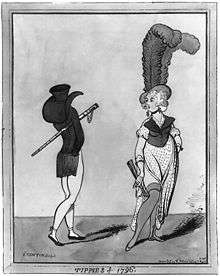Exaggeration
Exaggeration is the representation of something as more extreme or dramatic than it really is. The exaggerator has been a familiar figure in Western culture since at least Aristotle's discussion of the alazon: 'the boaster is regarded as one who pretends to have distinguished qualities which he possesses either not at all or to a lesser degree than he pretends...exaggerating'.[1]

It is the opposite of minimisation.
Words or expressions associated with exaggeration include:
- catastrophization
- hyperbole
- laying it on thick
- magnification
- maximization
- overblowing
- overplaying
- overreacting
- overstating
- stretching the truth
Everyday and psycho-pathological contexts
Contexts of exaggeration include:
Manipulation
The boasting and bragging by arrogant or manipulative people has been sent up on stage since the first appearance of the alazon – 'a stock character in Greek comedy'.[2] Inflated praise in the form of flattery and puffery has a similarly lengthy history.[3]
Amplifying achievements, obstacles and problems to seek attention is an everyday occurrence, as 'in exaggerating what one feels by magnifying the emotional expression: this is the ploy used by the six-year-old who dramatically twists her face into a pathetic frown, lips quivering, as she runs to complain to her mother about being teased'.[4]
Exaggerating is also a type of deception,[5] as well as a means of malingering – magnifying small injuries or discomforts as an excuse to avoid responsibilities.[6]
Cognitive distortions
Cognitive behavioral therapy views magnification (as opposed to minimization) as unconscious, unrealistic mental processing or cognitive distortion, which can take the form of probability overestimation or of catastrophizing. This is better known as 'making a big deal out of nothing.' 'Whereas probability overestimation refers to exaggerating the "likelihood" of an event, catastrophizing refers to exaggerating the "importance" of the event'.[7] Closely related 'is overgeneralizing, where one takes a single negative event and see it as a never-ending pattern of defeat'.[8]
Another form of cognitive exaggeration is inflation of the difficulty of achieving a goal after attaining it, possibly to improve self-esteem.[9]
In depression, exaggerated all-or-nothing thinking can form a self-reinforcing cycle: these thoughts might be called emotional amplifiers because, as they go around and around, they become more intense. Here are some typical all-or-nothing thoughts:
- my efforts are either a success or they are an abject failure
- I am/other people are either all good or all bad
- if you're not with us, you're against us[10]
Reaction formation
Reaction formation (German: Reaktionsbildung) is believed to be a defense mechanism in which emotions and impulses which are anxiety-producing or perceived to be unacceptable are mastered by exaggeration of the directly opposing tendency.[11]
Decatastrophizing
In cognitive therapy, decatastrophizing or decatastrophization is a cognitive restructuring technique to treat cognitive distortions, such as magnification and catastrophizing, commonly seen in psychological disorders like anxiety[12] and psychosis.[13]
Pathology
Psychoanalysis considered that neurotic exaggerations were the products of displacement[14] – overvaluations for example being used to maintain a repression elsewhere. Thus a conflict over ambivalence may be resolved by means of exaggerating one's love for a person so as to keep an unconscious hatred in further check.[15]
The grandiose sense of self-importance observed in narcissists[16] also uses exaggeration to thwart any recognition of a moderate fallibility, seeing any departure from complete success as total and hopeless failure.[17]
"Self-dramatization, theatricality, and exaggerated expression of emotion" can be observed in those with histrionic personality disorder[16] and other Cluster B personality disorders; while "catastrophizing" is associated with depressive, neurotic or paranoid behavior – focusing on the worst possible outcome, however unlikely, or thinking that a situation is unbearable or impossible when it is really just uncomfortable.[18][19]
Alarmism
Alarmism is excessive or exaggerated alarm about a real or imagined threat e.g. the increases in deaths from infectious disease.[21] The alarmist person is subject to the cognitive distortion of catastrophizing – of always expecting the worst of possible futures.[22]
Cultural manifestations
Humour

'Some theoreticians of the comic consider exaggeration to be a universal comic device'.[23] It may take different forms in different genres, but all rely on the fact that 'the easiest way to make things laughable is to exaggerate to the point of absurdity their salient traits'.[24]
Caricature
A caricature can refer to a portrait that exaggerates or distorts the essence of a person or thing to create an easily identifiable visual likeness: 'disproportionately increasing and emphasizing the defects of the features'.[25] In literature, a caricature is a description of a person using exaggeration of some characteristics and oversimplification of others.[26]
Slapstick
Slapstick is the recourse to humor involving exaggerated physical activity which exceeds the boundaries of common sense.[27][28][29] These exaggerated depictions are often found in cartoons, and light film comedies aimed at younger audiences.
Paradoxical laughter
Paradoxical laughter is an exaggerated expression of humor which is unwarranted by external events. It may be uncontrollable laughter which may be recognised as inappropriate by the person involved. Freud considered 'the compulsive laughter which so often occurs on mournful occasions'[30] the by-product of ambivalence.
Miles Gloriosus

The boastful soldier or Miles Gloriosus has for thousands of years formed part of the Western stage. 'The original miles gloriosus in Plautus is a son of Jove and Venus who has killed an elephant with his fist and seven thousand men in one day's fighting. In other words, he is trying to put on a good show: the exuberance of his boasting helps to put the play over'.[31]
Overacting
Overacting is the exaggeration of gestures and speech when acting. It may be unintentional, particularly in the case of a bad actor, or be required for the role. For the latter, it is commonly used in comical situations or to stress the evil characteristics of a villain. Since the perception of acting quality differs between people the extent of overacting can be subjective.
Animation
Exaggeration is an effect especially useful for animation, as perfect imitation of reality can look static and dull in cartoons.[32] The level of exaggeration depends on whether one seeks realism or a particular style, like a caricature or the style of a specific artist. The classical definition of exaggeration, employed by Disney, was to remain true to reality, just presenting it in a wilder, more extreme form.[33] Other forms of exaggeration can involve the supernatural or surreal, alterations in the physical features of a character; or elements in the storyline itself.[34] It is important to employ a certain level of restraint when using exaggeration. If a scene contains several elements, there should be a balance in how those elements are exaggerated in relation to each other, to avoid confusing or overawing the viewer.[35]
Shock jock
A shock jock, a type of radio broadcaster or disc jockey, entertains listeners or attracts attention using humor and/or melodramatic exaggeration that some portion of the listening audience may find offensive.
Media
Schopenhauer saw exaggeration as essential to journalism.[36] He may have exaggerated the case slightly, but yellow journalism thrived on exaggeration,[37] and fact-checking and independent verification have not succeeded in suppressing clickbait or hyperbolic headlines.
Politics
Politicians can exaggerate.[38] In the electoral process one may expect exaggeration.[39] Outside the electoral process the exaggerations of propaganda[40] can bolster the position of incumbents.
Advertising
Tragedy

Although the boaster (alazon) is primarily a comic figure, 'the alazon may be one aspect of the tragic hero as well: the touch of miles gloriosus in Tamburlaine, even in Othello, is unmistakable, as is the touch of the obsessed philosopher in Faustus and Hamlet'.[41]
Expressionism
'"Expressionist art"...attempted to intensify the expression of feeling and attitude by exaggeration'.[42] In its wake, even the 'new and hard realism...kept much of the distortion and exaggeration which had been one of the chief devices of earlier Expressionism'.[43]
Literary analogues
- In the BookWorld, warnings are issued about 'Poetry Island...any visit longer than a few hours will have an exaggerating effect on the senses. Upbeat poems will tend to have you laughing uncontrollably, while sombre poems will have you questioning your own worth in a most hideously self-obsessed manner'.[44]
- The Monty Python Dirty Fork sketch demonstrates an absurd level of catastrophization where restaurant staff commit suicide and murder each other because of a customer complaint of a dirty fork. Compare with the scene in the film Monty Python and the Holy Grail involving the Black Knight character which is the opposite extreme of absurdity (minimisation).
Metaphors
- "Making a mountain out of a molehill"
- "Blow out of proportion" or "Blow out of all proportion"
- "Make a song-and-dance of it"
- "Over-egg the pudding"
- "The sky is falling in"
- "World War III has broken out"
See also
- Auxesis (figure of speech)
- Fear mongering
- Henny Penny
- Hypercriticism
- Hypervigilance
- Idealization and devaluation
- Negativity effect
- Positivity effect
- Sexed up
- Spin
- Superiority complex
- Tall tales
References
- Aristotle, Ethics (Penguin 1976) p. 165.
- H. J. Rose, A Handbook of Latin Literature (London 1966)p. 49
- ""puff piece." Answers.com". The American Heritage Dictionary of Idioms. Houghton Mifflin Company. 1992. Retrieved 22 July 2006.
- Daniel Goleman, Emotional Intelligence (London 1996) p. 113.
- Guerrero, L., Anderson, P., Afifi, W. (2007). Close Encounters: Communication in Relationships (2nd ed.). Los Angeles: Sage Publications.
- R. Rogers Clinical Assessment of Malingering and Deception 3rd Edition, Guilford, 2008. ISBN 1-59385-699-7
- M. M. Antony/P. J. Norton, The Anti-Anxiety Workbook (2008) p. 83.
- Paul Gilbert, Overcoming Depression (London 1999) p. 286
- Beth Azar All puffed up Monitor on Psychology June 2007, Vol 38, No. 6.
- Gilbert, p. 63 and p. 98.
- "Defenses". psychpage.com. Retrieved 11 March 2008.
- Ryan C. Martin, Eric R. Dahlen (2005). "Cognitive emotion regulation in the prediction of depression, anxiety, stress, and anger". Personality and Individual Differences. 39 (November 2005): 1249–1260. doi:10.1016/j.paid.2005.06.004.CS1 maint: uses authors parameter (link)
- Steffen Moritza, Lisa Schillinga, Katja Wingenfeldb, Ulf Köthera, Charlotte Wittekinda, Kirsten Terfehrb, Carsten Spitzerb (2011). "Persecutory delusions and catastrophic worry in psychosis: Developing the understanding of delusion distress and persistence". Journal of Behavior Therapy and Experimental Psychiatry. 42 (September 2011): 349–354. doi:10.1016/j.jbtep.2011.02.003. PMID 21411041.CS1 maint: uses authors parameter (link)
- Otto Fenichel, The Psychoanalytic Theory of Neurosis (London 1994) p. 149
- Sigmund Freud, On Psychopathology (PFL 10) p. 317.
- Diagnostic and Statistical Manual of Mental Disorders Fourth edition Text Revision (DSM-IV-TR) American Psychiatric Association (2000).
- Neville Symington, Narcissism: A New Theory (London 1993) p. 71
- John M.Grohol; PsyD. "What is Catastrophizing? – Psych Central". Retrieved 1 March 2010.
- "Catastrophizing".
- Lasher, Louisa (2011). "MBP Definitions, Maltreatment Behaviors, and Comments". Archived from the original on 12 August 2011. Retrieved 30 January 2012.
- David Murray, Joel Schwartz (25 May 2008), "Alarmism is an infectious disease", Society, 34 (4): 35–40, doi:10.1007/BF02912206
- P. Gilbert, Overcoming Depression (1999) p. 88-90
- Emil Draitser, Techniques of Satire (1994) p. 135
- M. Eastman/W. Fry, Enjoyment of Laughter (2008) p. 156.
- Filippo Baldinucci, quoted in Harold Osborne ed., The Oxford Companion to Art (Oxford 1992) p. 204.
- "Literary Term Definition of Resolution".
- "slapstick – definition of slapstick by the Free Online Dictionary, Thesaurus and Encyclopedia". Thefreedictionary.com. Retrieved 29 April 2013.
- "Slapstick Comedy – film, cinema". Filmreference.com. Retrieved 29 April 2013.
- "Slapstick comedy definition of Slapstick comedy in the Free Online Encyclopedia". Encyclopedia2.thefreedictionary.com. Retrieved 29 April 2013.
- Sigmund Freud, Case Studies II (PFL 9) p. 74.
- Northrop Frye, Anatomy of Criticism (Princeton 1973) p. 165.
- Lightfoot, Nataha. "12 Principles". Animation Toolworks. Archived from the original on 9 June 2016. Retrieved 27 June 2008.
- Johnston & Thomas (1981), p. 65-6.
- Willian (29 June 2006). "Exaggeration". Blender. Archived from the original on 7 February 2009. Retrieved 28 June 2008.
- De Stefano, Ralph A. "Exaggeration". Electronic Visualization Laboratory, University of Illinois at Chicago. Archived from the original on 13 April 2001. Retrieved 28 June 2008.
-
Schopenhauer, Arthur (2017). Delphi Collected Works of Arthur Schopenhauer. Delphi Series Eight. 12. Hastings, East Sussex: Delphi Classics. p. 109. ISBN 9781786560889. Retrieved 21 June 2019.
Exaggeration of every kind is as essential to journalism as it is to the dramatic art; for the object of journalism is to make events go as far as possible. Thus it is that all journalists are, in the very nature of their calling, alarmists; and this is their way of giving interest to what they write.
-
Griffin, Brett (2018). Yellow Journalism, Sensationalism, and Circulation Wars. The Fourth Estate: Journalism in North America. New York: Cavendish Square Publishing, LLC. p. 102. ISBN 9781502634719. Retrieved 21 June 2019.
yellow journalism[: ...] a style of reporting that relied on exaggerted or invented stories of scandal and crime to attract readers; attention.
-
For example:
Anchimbe, Eric A. (2012). "Private dialogue in public space: 'Motions of support' letters as response to political action". In Berlin, Lawrence N.; Fetzer, Anita (eds.). Dialogue in Politics. Dialogue studies. 18. Amsterdam: John Benjamins Publishing. p. 144. ISBN 9789027210357. Retrieved 21 June 2019.
Several communicative strategies commonly identified with political discourse produced by politicians can be found in the MoS written by the common people in a bid to represent their voices in the political process in Cameroon. Among these strategies are persuasion, exaggeration, manipulation, vagueness, and falsehood.
-
For example:
Fraser, Tony (2009). "Trinidad and Tobago". In Esipisu, Manoah; Khaguli, Isaac E. (eds.). Eyes of Democracy: The Media and Elections. London: Commonwealth Secretariat. p. 52. ISBN 9780850928983. Retrieved 21 June 2019.
The first requirement of a journalist covering an election in Trinidad and Tobago is to understand the multicultural nature and culture of the people, the disposition to exaggeration of politicians and political parties, the apparent contradictions of the culture and to vow not to take the country's politics too seriously.
-
Jowett, Garth; O'Donnell, Victoria (2006). "How to Analyze Propaganda". Propaganda and Persuasion (4 ed.). Thousand Oaks, California: SAGESage Publications. p. 283. ISBN 9781412908986. Retrieved 21 June 2019.
Exaggeration is often associated with propaganda. Goebbels said that outrageous charges evoked more belief than milder statements.
- Frye, p. 39.
- Harold Bloom, Thomas Hardy (2010) p. 93
- Harold Osborne ed., The Oxford Companion to Art (Oxford 1992) p. 397.
- Jasper Fforde, One of Our Thursdays is Missing (London 2011) p. 249.
Further reading
Books
- Duttmann, AG; Phillips, J Philosophy of Exaggeration (Continuum Studies in Continental Philosophy) (2007)
Academic papers
- Clayer, JR; Bookless, C; Ross, MW Neurosis and conscious symptom exaggeration: Its differentiation by the illness behaviour questionnaire Journal of Psychosomatic Research Volume 28, Issue 3, 1984, Pages 237–241
- Demaree, HA; Schmeichel, BJ; Robinson, JL; Everhart, D. Erik Behavioural, affective, and physiological effects of negative and positive emotional exaggeration. Cognition and Emotion, Volume 18, Number 8, 2004, 1079–1097(19)
- Masterson, J; Dunworth, R; Williams, N Extreme illness exaggeration in pediatric patients: A variant of Munchausen's by Proxy?. American Journal of Orthopsychiatry. Vol 58(2), Apr 1988, 188–195.
- McNicholas, F Slonims, V & Cass H Exaggeration of Symptoms or Psychiatric Munchausen's Syndrome by Proxy? Child and Adolescent Mental Health 2003 Volume 5 Issue 2, Pages 69 – 75
- Mittenberg, W; Patton, C; Canyock, EM; Condit, DC Base rates of malingering and symptom exaggeration. Journal of Clinical and Experimental Neuropsychology. Vol 24(8), Dec 2002, 1094–1102.
- Mueller, J Simplicity and spook: Terrorism and the dynamics of threat exaggeration International Studies Perspectives, 2005
- Pieper, WJ Exaggeration, puffery, inferential beliefs and deception in advertising – 1976 – University of South Carolina.
- Sperling, OE Exaggeration as a Defense. Psychoanal Q., 32:553-548. (1963).
External links
| Look up exaggeration in Wiktionary, the free dictionary. |